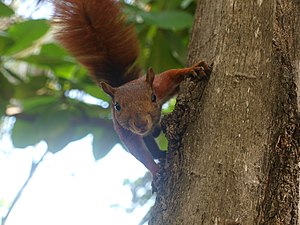Colombian squirrel
| Colombian squirrel | ||||||||||||
|---|---|---|---|---|---|---|---|---|---|---|---|---|

Colombian red squirrel ( Sciurus pucheranii ) |
||||||||||||
| Systematics | ||||||||||||
|
||||||||||||
| Scientific name | ||||||||||||
| Sciurus pucheranii | ||||||||||||
| ( Fitzinger , 1867) |
The Colombian squirrel ( Sciurus pucheranii ) is a species of squirrel from the genus of squirrels ( Sciurus ). It occurs in the Colombian Andes in northern South America.
features
The Colombian squirrel reaches a head-torso length of about 14.0 to 18.4 centimeters, in addition to a tail that is about 11.9 to 16.0 centimeters long. The weight is 100 to 146 grams. The back color is reddish brown, sometimes with a dark median stripe along the spine. The ventral side is gray to yellow in color. The tail hairs are black on both the top and bottom and have white tips, creating a white frost. Some individuals have a patch of black hair on their foreheads. The fur of the animals is very soft and dense, the ears are only slightly hairy.
distribution
The Colombian squirrel is endemic to the Colombian Andes in northern South America.
Way of life
The Colombian squirrel lives in the mountain forest areas of the Andes and their surroundings at altitudes of 2200 to 3500 meters. Only very limited data and observations are available on the way of life of the animals. Like other squirrels, it is diurnal and lives in the trees. With their very dense fur, the animals are adapted to the cold and damp climates of the altitude of their habitat. The forests of the distribution area are dense and reach heights of up to 35 meters. Sometimes the animals are in competition with the larger red-tailed squirrels ( S. granatensis ) and are driven away by resin sources.
Systematics
The Colombian squirrel is classified as a separate species within the genus of squirrels ( Sciurus ), which consists of almost 30 species. The first scientific description comes from Leopold Fitzinger from 1867, who described the species using individuals from the region near Bogotá in Colombia.
Within the species, three subspecies are distinguished with the nominate form :
- Sciurus pucheranii pucheranii : nominate form; The animals occur in the area of the Colombian capital Bogotá and in the eastern Andes. The dark midline is usually missing, the ventral side is brownish in color with a sand-colored chest region.
- Sciurus pucheranii caucensis : in the western Colombian Andes. The dark center line is usually missing, the ventral side is brownish in color with an olive to sand-colored wash.
- Sciurus pucheranii medellinensis : the type comes from the region near the city of Medellín . The animals usually have a well-developed dark midline and the ventral side is whitish.
Status, threat and protection
The International Union for Conservation of Nature and Natural Resources (IUCN) does not classify the Colombian squirrel in a hazard category due to insufficient data on stocks, taxonomy and ecological needs, but is listed as "data deficient".
In the Colombian Andes, forests are becoming increasingly fragmented due to logging; elsewhere there are reforestation projects. Targeted hunting of the animals is unlikely due to their small size.
supporting documents
- ↑ a b c d e f g Richard W. Thorington Jr. , John L. Koprowski, Michael A. Steele: Squirrels of the World. Johns Hopkins University Press, Baltimore MD 2012, ISBN 978-1-4214-0469-1 , pp. 65-66 .
- ↑ a b Sciurus pucheranii in the Red List of Threatened Species of the IUCN 2015.3. Posted by: G. Amori, J. Koprowski, L. Roth, 2008. Accessed November 14, 2015.
- ↑ a b Sciurus pucheranii In: Don E. Wilson , DeeAnn M. Reeder (Ed.): Mammal Species of the World. A taxonomic and geographic Reference. 2 volumes. 3. Edition. Johns Hopkins University Press, Baltimore MD 2005, ISBN 0-8018-8221-4 .
literature
- Richard W. Thorington Jr. , John L. Koprowski, Michael A. Steele: Squirrels of the World. Johns Hopkins University Press, Baltimore MD 2012, ISBN 978-1-4214-0469-1 , pp. 65-66 .
Web links
- Sciurus pucheranii inthe IUCN Red List of Threatened Species 2015.3. Posted by: G. Amori, J. Koprowski, L. Roth, 2008. Accessed November 14, 2015.